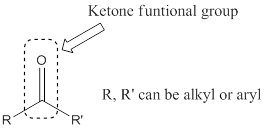
Concept explainers
(a)
Interpretation:
The model structure has to be converted into line drawing along with identification of Functional Group.
Concept Introduction:
Line structure is a simple and quick way to represent organic molecules without showing carbons and hydrogens present. Drawing a molecule in this way is very simple:
It follows the following guide line:
- Each carbon- carbon bond is represented by a line.
- Anywhere a line ends or begins, as well as any vertex where two lines meet represents a carbon atom.
- Any atom other than another’s carbon or hydrogen attached to a carbon must be shown.
- Since a neutral carbon atom form four bonds, all bonds not shown for any carbon are understood to be the number of carbon – hydrogen bonds needed to have.
Functional group: Organic compounds can be classified into various families according to the


Ether: A class of organic compounds, where oxygen is attached to two alkyl or aryl groups.

(b)
Interpretation:
The model structure has to be converted into line drawing along with identification of Functional Group.
Concept Introduction:
Line structure is a simple and quick way to represent organic molecules without showing carbons and hydrogens present. Drawing a molecule in this way is very simple:
It follows the following guide line:
- Each carbon- carbon bond is represented by a line.
- Anywhere a line ends or begins, as well as any vertex where two lines meet represents a carbon atom.
- Any atom other than another’s carbon or hydrogen attached to a carbon must be shown.
- Since a neutral carbon atom form four bonds, all bonds not shown for any carbon are understood to be the number of carbon – hydrogen bonds needed to have.
Functional group: Organic compounds can be classified into various families according to the functional groups they contain a functional group is a part of a larger molecule and is composed of a group of atoms that has characteristic structure and chemical reactivity.
Functional group:
An atom or group of atoms which has physical and chemical properties is known as functional group.
Ketone: A compound containing a carbonyl group

Alkene: Unsaturated hydrocarbons containing double bonds.

Ether: A class of organic compounds, where oxygen is attached to two alkyl or aryl groups.

Want to see the full answer?
Check out a sample textbook solution
Chapter 12 Solutions
Fundamentals of General, Organic, and Biological Chemistry, Books a la Carte Plus Mastering Chemistry with Pearson eText -- Access Card Package (8th Edition)
- Calculate pH of a solution prepared by dissolving 1.60g of sodium acetate, in 88.5 mL of 0.10 M acetic acid. Assume the volume change upon dissolving the sodium acetate is negligible. Ka is 1.75 x 10^-5arrow_forwardShow a mechanism that leads to the opening of the ring below under acid-catalyzed conditions. Give the correct Fischer projection for this sugar.arrow_forwardWhat is the stereochemical relationship between B & C?arrow_forward
- Don't use ai or any chat gpt will dislike okk just use accurate information okkk okkk just solve full accurate. don't use guidelines okk just did it accurate 100% sure experts solve it correct complete solutions okkk follow all instructions requirements okkkarrow_forwardhow would you make this plot in excel?arrow_forwardwhat is the productarrow_forward
- Balance the following equation and list of coefficients in order from left to right. SF4+H2O+—-> H2SO3+HFarrow_forwardProblem 15 of 15 Submit Using the following reaction data points, construct Lineweaver-Burk plots for an enzyme with and without an inhibitor by dragging the points to their relevant coordinates on the graph and drawing a line of best fit. Using the information from this plot, determine the type of inhibitor present. 1 mM-1 1 s mM -1 [S]' V' with 10 μg per 20 54 10 36 20 5 27 2.5 23 1.25 20 Answer: |||arrow_forward12:33 CO Problem 4 of 15 4G 54% Done On the following Lineweaver-Burk -1 plot, identify the by dragging the Km point to the appropriate value. 1/V 40 35- 30- 25 20 15 10- T Км -15 10 -5 0 5 ||| 10 15 №20 25 25 30 1/[S] Г powered by desmosarrow_forward
 Principles Of Radiographic Imaging: An Art And A ...Health & NutritionISBN:9781337711067Author:Richard R. Carlton, Arlene M. Adler, Vesna BalacPublisher:Cengage Learning
Principles Of Radiographic Imaging: An Art And A ...Health & NutritionISBN:9781337711067Author:Richard R. Carlton, Arlene M. Adler, Vesna BalacPublisher:Cengage Learning Biology (MindTap Course List)BiologyISBN:9781337392938Author:Eldra Solomon, Charles Martin, Diana W. Martin, Linda R. BergPublisher:Cengage Learning
Biology (MindTap Course List)BiologyISBN:9781337392938Author:Eldra Solomon, Charles Martin, Diana W. Martin, Linda R. BergPublisher:Cengage Learning





